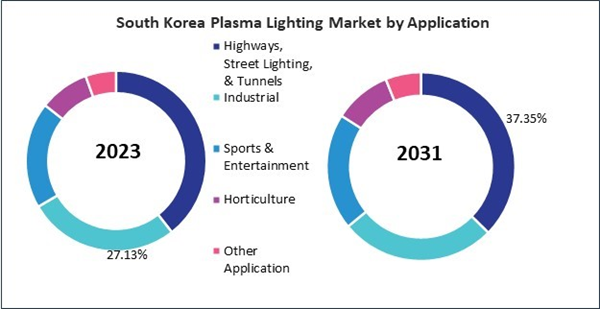The Asia Pacific Plasma Lighting Market is expected to witness market growth of 5.7% CAGR during the forecast period (2024-2031).
The China market dominated the Asia Pacific Plasma Lighting Market by Country in 2023, and is expected to continue to be a dominant market till 2031; thereby, achieving a market value of $73.96 millions by 2031. The Japan market is registering a CAGR of 5.1% during 2024-2031. Additionally, the India market would witness a CAGR of 6.4% during 2024-2031.
Plasma lighting’s ability to produce a full-spectrum light that resembles natural sunlight makes it highly valuable in industries requiring clear and accurate illumination. In horticulture, plasma lighting supports robust plant growth by providing the ideal light spectrum necessary for photosynthesis, making it beneficial for indoor farms and greenhouses. Countries like Japan utilize plasma lighting in urban farms to grow crops efficiently and sustainably, maximizing limited agricultural space.
In healthcare, the presence of minimal UV and IR emissions fosters a comfortable environment for patients and healthcare professionals, which is also a benefit of this natural light quality. Hospitals and clinics in Europe have found plasma lighting beneficial for reducing eye strain and skin irritation while enhancing visibility in critical areas such as surgical units, ultimately supporting patient care and staff well-being.
Australia is seeing increased adoption of plasma lighting within horticulture as the agriculture sector shifts toward indoor and controlled-environment farming to overcome climate challenges and boost year-round production. Plasma lighting’s spectrum, similar to natural sunlight, supports optimal plant growth and is thus becoming popular for greenhouses and vertical farming. The Australian government has provided support through initiatives like the National Innovation and Science Agenda, promoting research and development in sustainable agriculture technologies.
Additionally, grants for energy-efficient lighting in agricultural facilities further encourage the shift to plasma lighting, especially in regions affected by water scarcity and temperature fluctuations, where indoor farming solutions are critical. Therefore, as Asia-Pacific economies expand, plasma lighting’s specialized applications and support from green technology policies are expected to drive further market growth across the region.
The China market dominated the Asia Pacific Plasma Lighting Market by Country in 2023, and is expected to continue to be a dominant market till 2031; thereby, achieving a market value of $73.96 millions by 2031. The Japan market is registering a CAGR of 5.1% during 2024-2031. Additionally, the India market would witness a CAGR of 6.4% during 2024-2031.
Plasma lighting’s ability to produce a full-spectrum light that resembles natural sunlight makes it highly valuable in industries requiring clear and accurate illumination. In horticulture, plasma lighting supports robust plant growth by providing the ideal light spectrum necessary for photosynthesis, making it beneficial for indoor farms and greenhouses. Countries like Japan utilize plasma lighting in urban farms to grow crops efficiently and sustainably, maximizing limited agricultural space.
In healthcare, the presence of minimal UV and IR emissions fosters a comfortable environment for patients and healthcare professionals, which is also a benefit of this natural light quality. Hospitals and clinics in Europe have found plasma lighting beneficial for reducing eye strain and skin irritation while enhancing visibility in critical areas such as surgical units, ultimately supporting patient care and staff well-being.
Australia is seeing increased adoption of plasma lighting within horticulture as the agriculture sector shifts toward indoor and controlled-environment farming to overcome climate challenges and boost year-round production. Plasma lighting’s spectrum, similar to natural sunlight, supports optimal plant growth and is thus becoming popular for greenhouses and vertical farming. The Australian government has provided support through initiatives like the National Innovation and Science Agenda, promoting research and development in sustainable agriculture technologies.
Additionally, grants for energy-efficient lighting in agricultural facilities further encourage the shift to plasma lighting, especially in regions affected by water scarcity and temperature fluctuations, where indoor farming solutions are critical. Therefore, as Asia-Pacific economies expand, plasma lighting’s specialized applications and support from green technology policies are expected to drive further market growth across the region.
List of Key Companies Profiled
- Gavita International B.V.
- BIRNS, Inc.
- Hive Lighting, Inc.
- Pure Plasma Lighting Inc.
- LG Electronics, Inc. (LG Corporation)
- Green de Corp.
- Solaronix SA
- Light Emitting Designs
- Stray Light Optical Technologies
Market Report Segmentation
By Component
- Bulb Assembly
- Cavity Resonator
- Waveguide
- Lightron
By
Wattage
- 300W
- 700W
- 1000W
By Application
- Highways, Street Lighting, & Tunnels
- Industrial
- Sports & Entertainment
- Horticulture
- Other Application
By Country
- China
- Japan
- India
- South Korea
- Singapore
- Malaysia
- Rest of Asia Pacific
Table of Contents
Chapter 1. Market Scope & Methodology
Chapter 2. Market at a Glance
Chapter 3. Market Overview
Chapter 4. Asia Pacific Plasma Lighting Market by Component
Chapter 5. Asia Pacific Plasma Lighting Market by Wattage
Chapter 6. Asia Pacific Plasma Lighting Market by Application
Chapter 7. Asia Pacific Plasma Lighting Market by Country
Chapter 8. Company Profiles
Companies Mentioned
- Gavita International B.V.
- BIRNS, Inc.
- Hive Lighting, Inc.
- Pure Plasma Lighting Inc.
- LG Electronics, Inc. (LG Corporation)
- Green de Corp.
- Solaronix SA
- Light Emitting Designs
- Stray Light Optical Technologies
Methodology

LOADING...









